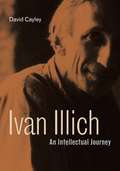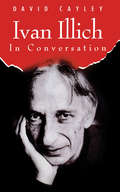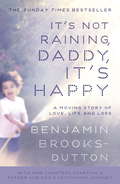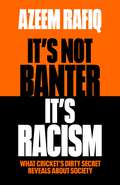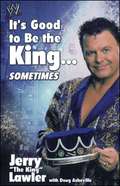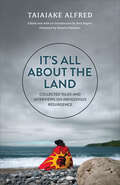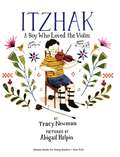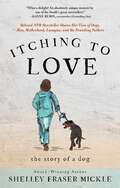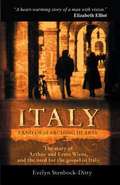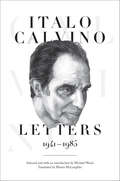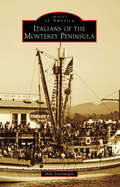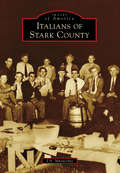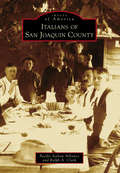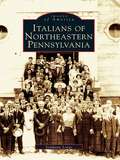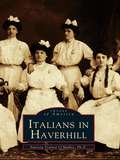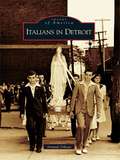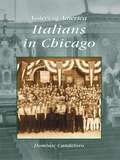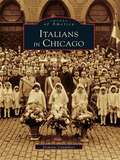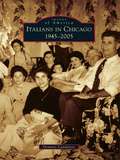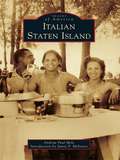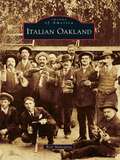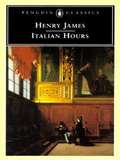- Table View
- List View
Ivan Illich: An Intellectual Journey (Ivan Illich: 21st-Century Perspectives #2)
by David CayleyIn the eighteen years since Ivan Illich’s death, David Cayley has been reflecting on the meaning of his friend and teacher’s life and work. Now, in Ivan Illich: An Intellectual Journey, he presents Illich’s body of thought, locating it in its own time and retrieving its relevance for ours.Ivan Illich (1926–2002) was a revolutionary figure in the Roman Catholic Church and in the wider field of cultural criticism that began to take shape in the 1960s. His advocacy of a new, de-clericalized church and his opposition to American missionary programs in Latin America, which he saw as reactionary and imperialist, brought him into conflict with the Vatican and led him to withdraw from direct service to the church in 1969. His institutional critiques of the 1970s, from Deschooling Society to Medical Nemesis, promoted what he called institutional or cultural revolution. The last twenty years of his life were occupied with developing his theory of modernity as an extension of church history. Ranging over every phase of Illich’s career and meditating on each of his books, Cayley finds Illich to be as relevant today as ever and more likely to be understood, now that the many convergent crises he foresaw are in full public view and the church that rejected him is paralyzed in its "folkloric" shell.Not a conventional biography, though attentive to how Illich lived, Cayley’s book is "continuing a conversation" with Illich that will engage anyone who is interested in theology, philosophy, history, and the Catholic Church.
Ivan Illich: An Intellectual Journey (Ivan Illich #2)
by David CayleyIn the eighteen years since Ivan Illich’s death, David Cayley has been reflecting on the meaning of his friend and teacher’s life and work. Now, in Ivan Illich: An Intellectual Journey, he presents Illich’s body of thought, locating it in its own time and retrieving its relevance for ours.Ivan Illich (1926–2002) was a revolutionary figure in the Roman Catholic Church and in the wider field of cultural criticism that began to take shape in the 1960s. His advocacy of a new, de-clericalized church and his opposition to American missionary programs in Latin America, which he saw as reactionary and imperialist, brought him into conflict with the Vatican and led him to withdraw from direct service to the church in 1969. His institutional critiques of the 1970s, from Deschooling Society to Medical Nemesis, promoted what he called institutional or cultural revolution. The last twenty years of his life were occupied with developing his theory of modernity as an extension of church history. Ranging over every phase of Illich’s career and meditating on each of his books, Cayley finds Illich to be as relevant today as ever and more likely to be understood, now that the many convergent crises he foresaw are in full public view and the church that rejected him is paralyzed in its “folkloric” shell.Not a conventional biography, though attentive to how Illich lived, Cayley’s book is “continuing a conversation” with Illich that will engage anyone who is interested in theology, philosophy, history, and the Catholic Church.
Ivan Illich in Conversation: The Testament of Ivan Illich
by David CayleyFor more than fifteen years, iconoclastic thinker Ivan Illich refused to be interviewed. Finally, in 1988, CBC's David Cayley persuaded Illich to record a conversation. This first interview led to additional sessoins that continued until 1992 and are now gathered in Ivan Illich in Conversation. In these fascinating conversations, which range over a wide selection of the celebrated thinker's published work and public career, Illich's brilliant mind alights on topics of great contemporary interest, including education, history, language, politics, and the church.
It’s Not Raining, Daddy, It's Happy
by Benjamin Brooks-DuttonThe Sunday Times bestsellerThe moving and inspiring account of heartbreak and courage, and the life-affirming relationship between a father and son. Ben Brooks-Dutton's wife - the great love of his life - was knocked down and killed by a car as he walked beside her, pushing their two-year-old son in his buggy. Life changed forever. Suddenly Ben was a widower deep in shock, left to raise their bewildered child alone. In the aftermath Ben searched for guidance from men in similar situations, but it appeared that young widowed fathers don't talk. Well meaning loved ones admired his strength. The unwritten rule seemed to be to 'shut up, man up and hide your pain'. Lost, broken and afraid of the future, two months after his wife Desreen's death, Ben started a blog with the aim of rejecting outdated conventions of grief and instead opening up about his experiences. Within months Life as a Widower, had received a million hits and had started an all-too-often hushed conversation about the reality of loss and grief. This is the story of a man and a child who lost the woman they so dearly love and what happened in the year that followed. Ben describes the conflicting emotions that come from facing grief head on. He rages against the clichés used around loss and shows the strange and cruel ways in which grief can take hold. He also charts what it means to become a sole parent to a child who has lost their mother and cannot yet understand the meaning of death. Through the shock and sadness shine moments of hope and insight. So much of what Ben learns comes from watching his son struggle, survive and live, as children do, from moment to moment where hurt can turn to happiness and anger can turn to joy. This is a story of loss, heartbreak and courage. At its heart is the funny, infuriating and life affirming relationship between a father and son and their ongoing love for an extraordinary woman.
It’s Not Banter, It’s Racism: What Cricket’s Dirty Secret Reveals About Our Society
by Azeem RafiqTHE STORY OF ONE MAN WHO CHANGED THE FACE OF CRICKET FOREVER.'Azeem's first legacy - a legacy carved at great personal expense - was to expose how cricket works. His second gift may be to expose how this country works, too.' Jonathan LiewWhen Azeem Rafiq was a young boy playing cricket near his home in Pakistan, he could never have foreseen that this sport would change his life forever. He fell in love with the game quickly and it wasn't long before the white flannels and green grass felt like home to him. When he moved to England, he became the youngest man to captain a Yorkshire side and the first person of Asian descent to do so. His talent was undeniable, and doors were opening for him.But there was something Azeem was bottling up and it was about to explode out of him and shake the whole cricket world, and wider society, out of their slumber. It's Not Banter, It's Racism is the never before-told truth behind the racism accusations that shocked a nation, from the moment Azeem spoke up to the resulting events that have altered his world entirely. With heartbreaking honesty, Azeem reveals why he will always use his voice in a society that would prefer him to be voiceless.'Azeem has stood up to the world, spoken back against evil. He has had victories. He has failed. He extends charity to others and he says no: no to racism. Because we must be better than our worst.' Stan Grant'Azeem's dream was to help England win the Ashes. That wasn't to be. But maybe, one day we'll reflect that his legacy to the game is far greater than winning any amount of Test series.' George Dobell'A principled whistleblower who stood up for what was right, Azeem has changed cricket forever.' Jennifer Robinson'Honest, open and powerful.' Baroness Warsi
It’s Not Banter, It’s Racism: What Cricket’s Dirty Secret Reveals About Our Society
by Azeem RafiqTHE STORY OF ONE MAN WHO CHANGED THE FACE OF CRICKET FOREVER.'Azeem's first legacy - a legacy carved at great personal expense - was to expose how cricket works. His second gift may be to expose how this country works, too.' Jonathan LiewWhen Azeem Rafiq was a young boy playing cricket near his home in Pakistan, he could never have foreseen that this sport would change his life forever. He fell in love with the game quickly and it wasn't long before the white flannels and green grass felt like home to him. When he moved to England, he became the youngest man to captain a Yorkshire side and the first person of Asian descent to do so. His talent was undeniable, and doors were opening for him.But there was something Azeem was bottling up and it was about to explode out of him and shake the whole cricket world, and wider society, out of their slumber. It's Not Banter, It's Racism is the never before-told truth behind the racism accusations that shocked a nation, from the moment Azeem spoke up to the resulting events that have altered his world entirely. With heartbreaking honesty, Azeem reveals why he will always use his voice in a society that would prefer him to be voiceless.'Azeem has stood up to the world, spoken back against evil. He has had victories. He has failed. He extends charity to others and he says no: no to racism. Because we must be better than our worst.' Stan Grant'Azeem's dream was to help England win the Ashes. That wasn't to be. But maybe, one day we'll reflect that his legacy to the game is far greater than winning any amount of Test series.' George Dobell'A principled whistleblower who stood up for what was right, Azeem has changed cricket forever.' Jennifer Robinson'Honest, open and powerful.' Baroness Warsi
It’s Never Too Late: Make the Next Act of Your Life the Best Act of Your Life
by Kathie Lee GiffordFormer Today show host Kathie Lee Gifford draws on stories from her remarkable life to weave together a beautiful reminder that whatever circumstances we face, God is still dreaming big for our years ahead. When Kathie Lee Gifford stepped down as cohost of the fourth hour of the Today show with Hoda Kotb, you might have thought her best days were behind her. It turns out, she was just getting started. As Kathie Lee says, &“I&’m not retiring; I&’m refiring!&” Taking us from her Chesapeake Bay childhood when she first heard God&’s calling, to her skyrocketing fame with Regis, to her decision to leave television for Nashville, Kathie Lee inspires us to pursue what really matters. Because it&’s never too late to forgive, to dance the cha-cha, or to make a difference in the world. God placed His dreams in your heart for a reason. And like Kathie Lee, you might just discover that the best is yet to come. Whether you&’re an empty nester, newly single, navigating a career change, or just eager for any change, Kathie Lee helps you hear God&’s loving calling because It&’s Never Too Late to . . .Begin AgainMake Sparks FlyLeave a Good ThingHave a PartyChange the Ending, Then Change It AgainIs it time for you to rewrite your story, unearth your hidden passions, and live with a renewed purpose? It&’s never too late.
It’s Good to Be the King... Sometimes
by Jerry "The King" LawlerJerry Lawler is hailed as one of sports-entertainment's most enduring and colorful characters. His life has been filled with hilarious, never-been-told stories... until now! His reign consists of thirteen championships (one of which he's held more than forty times), three marriages, and two children. He's dominated Memphis radio and television airwaves. Starred in feature films. Recorded albums. Tolerated countless sprains, broken bones, concussions, and contusions. The way Jerry "The King" Lawler tells it, if you're good at something, do it more than once. It's Good To Be The King... Sometimes is a no-holds-barred personal account from the "puppies"-pantin' King of one-liners, who steps out from behind the announcer's desk of WWE Raw to hold court about everything. His passion for art that first drew him to the ring of a rundown West Memphis movie theater over thirty years ago. The comic adventures and tragic bumps endured journeying down the "Music Highway" of Interstate 40 with the National Wrestling Alliance. Earning his royal personage in the Bluff City of the Mighty Mississippi against his own mentor, "Fabulous" Jackie Fargo. Grappling with mat legends Ric Flair, Lou Thesz, Jesse Ventura, Andre the Giant, Terry Funk, and Bret "Hitman" Hart. And his crowning achievements as co-ruler of the United States Wrestling Association, which contributed to the rise of future WWE Superstars Hulk Hogan, Undertaker, Stone Cold Steve Austin, and The Rock. It's time you lackeys pay heed as the King reveals the schemes and outrageous story lines to many of wrestling's most fantastic theatrics and all-too-real moments. Lawler tells of his legendary "feud" with Andy Kaufman, and his much-publicized confrontation with the actor portraying the late comedian on the set of Man on the Moon,and the "Karate-versus-Wrestling" match that almost occurred between Lawler and Memphis's other King. And be sure to honor his royal proclamations regarding former wives, and his mother's opinion of wrestling; why he once sued future boss Vince McMahon... and won; and the body part he truly worships on a WWE Diva.
It’s All about the Land: Collected Talks and Interviews on Indigenous Resurgence
by Taiaiake AlfredIlluminating the First Nations struggles against the Canadian state, It’s All about the Land exposes how racism underpins and shapes Indigenous-settler relationships. Renowned Kahnawà:ke Mohawk activist and scholar Taiaiake Alfred explains how the Canadian government’s reconciliation agenda is a new form of colonization that is guaranteed to fail. Bringing together Alfred’s speeches and interviews from over the past two decades, the book shows that Indigenous peoples across the world face a stark choice: reconnect with their authentic cultures and values or continue following a slow road to annihilation. Rooted in ancestral spirit, knowledge, and law, It’s All about the Land presents a passionate argument for Indigenous Resurgence as the pathway toward justice for Indigenous peoples.
Itzhak A Boy Who Loved the Violin: A Boy Who Loved The Violin
by Tracy NewmanItzhak Perlman was infected with polio at the age of four and despite this he went on to become an acclaimed violinist.
Itching to Love
by Shelley MickleA beloved NPR storyteller and award-winning author discovers life after kids when a neighbor's dog steals her things--and her heart--in this hilarious and uplifting memoir.In this hilarious memoir, award-winning author Shelley Fraser Mickle takes readers on a humorous yet heartwarming and intimate journey into a slice of her life. Itching to Love gives readers not only laughs but also a realization that their own lives are a singular magnificence enhanced by unexpected detours. Shelley shares how a woman discovers her neighbor&’s dog has been stealing her things and stashing them next to his food bowl and forcing her to ponder, What did he see in her that she did not see in herself? Never in her wildest dreams would she have predicted that she would fall in love with a dog with yellow snake eyes who refuses to let her be owned by anyone else. In this short memoir you will find yourself smiling, laughing, and crying as Shelley introduces you to astronauts, Founding Fathers, family members we can all relate to, along with many others who educated her heart. And, of course, Buddy the ordinary dog who sensed she was secretly harboring an unrecognized sorrow. When her second novel Replacing Dad was translated into film, one reviewer said it was the funniest story since Auntie Mame. Yes, Shelley is indeed funny, which is why NPR in Washington D.C. called one day to ask her to tell her stories on Morning Edition, which she did for six years.
Italy, Land of Searching Hearts: The Story of Arthur and Emma Wiens, and the Need for the Gospel in Italy
by Evelyn Stenbock-DittyA True Story from the forgotten mission field of Europe. "Italy is one of the most neglected mission fields in all Europe. Art Wiens has had a lifetime of service there and he is one of my heroes." George Verwer, Operation Mobilisation. "Art and Erma Wiens are the true prototype of those who have led the way in missionary work in Europe... will help in the understanding of the challenge of Europe as a mission field."
Italo Calvino: Letters, 1941–1985
by Italo CalvinoThe first collection of letters in English by one of the great writers of the twentieth centuryThis is the first collection in English of the extraordinary letters of one of the great writers of the twentieth century. Italy's most important postwar novelist, Italo Calvino (1923-1985) achieved worldwide fame with such books as Cosmicomics, Invisible Cities, and If on a Winter’s Night a Traveler. But he was also an influential literary critic, an important literary editor, and a masterful letter writer whose correspondents included Umberto Eco, Primo Levi, Gore Vidal, Leonardo Sciascia, Natalia Ginzburg, Michelangelo Antonioni, Pier Paolo Pasolini, and Luciano Berio. This book includes a generous selection of about 650 letters, written between World War II and the end of Calvino’s life. Selected and introduced by Michael Wood, the letters are expertly rendered into English and annotated by well-known Calvino translator Martin McLaughlin.The letters are filled with insights about Calvino’s writing and that of others; about Italian, American, English, and French literature; about literary criticism and literature in general; and about culture and politics. The book also provides a kind of autobiography, documenting Calvino’s Communism and his resignation from the party in 1957, his eye-opening trip to the United States in 1959-60, his move to Paris (where he lived from 1967 to 1980), and his trip to his birthplace in Cuba (where he met Che Guevara). Some lengthy letters amount almost to critical essays, while one is an appropriately brief defense of brevity, and there is an even shorter, reassuring note to his parents written on a scrap of paper while he and his brother were in hiding during the antifascist Resistance.This is a book that will fascinate and delight Calvino fans and anyone else interested in a remarkable portrait of a great writer at work.
Italians of the Monterey Peninsula
by Mike VentimigliaSince the early 1900s, Monterey was known for its fishing, mostly for salmon and the abalone that was plentiful in Monterey Bay. The migration of the Sicilian Italian community is credited for reaping what was called the "Silver Harvest." The Silver Harvest is the name that was given to the fishing of sardines in Monterey, which mostly was done by the Sicilian Italians who established the working fabric in the sardine industry for nearly five decades. Most of that generation is gone, and only a few are memorialized in books. It is this author's attempt to capture the working class that made Monterey the "Sardine Capital of the World."
Italians of Stark County (Images of America)
by J. A. MusacchiaImages of America: Italians of Stark County focuses on Italian immigration into Stark County beginning in the late 1800s. At the time, Stark County's urban hub of Canton and the surrounding communities were in the middle of a thriving expansion driven by industry, transportation, and manufacturing. Along with this growth came the need for labor, with immigration filling many of those needs. Italians came to Stark County to work in the steel mills, in the coal mines, and on the railroad, as well as to start their own small businesses. Once established, Italian families began to replicate the community foundations from their native land, and in turn these foundations reinforced embedded values: family, food, religion, music, and freedom.
Italians of San Joaquin County (Images of America)
by Ralph A. Clark Pacific Italian AllianceItalians were among the first European settlers in California, as fishermen from Italy arrived in the 1830s. After gold was discovered in 1848, immigrants from all over the world came for the opportunity that California presented. For the Italians, they encountered a terrain and climate so similar to their homeland that many stayed on to make California their new home. In San Joaquin County, the Italian influence remains profound, with the immigrants and their descendants helping develop the area's cultural, agricultural, and business climate into what it is today. The legacy of the Italian pioneers has enriched San Joaquin County in immeasurable ways. Every aspect of life here has been touched, molded, and made better by this industrious group who came to a distant land to make a better life.
Italians of Northeastern Pennsylvania (Images of America)
by Stephanie LongoEvery Labor Day weekend, hundreds of thousands of people flock to Courthouse Square in Scranton for the largest ethnic festival in northeastern Pennsylvania: La Festa Italiana. The Italians of this region have been proudly celebrating their heritage since their arrival in this country with traditional festivals, including La Corsa dei Ceri in Jessup and Dunmore's procession in honor of St. Rocco. Using vintage and recent photographs, Italians of Northeastern Pennsylvania shows how the Italian immigrants to this area, some of whom arrived with little more than the clothes on their back, became well-respected community leaders. Through hard work and dedication, they have made northeastern Pennsylvania into an area that defines the term "ethnic pride."
Italians in Haverhill
by Patricia Trainor O’malleyItalian immigrants became permanent residents of Haverhill in the 1870s. The original Genoese first drew their relatives and friends from their home area to join them. Over the next few decades, they were joined by families from the central province of Abruzzi and from the towns and villages around Naples. Immigrants from parts of southern Italy, such as Calabria and Apulia and Sicily, settled here. All of the Italians, whether northern or southern, brought with them their culture, their vitality, their love of music, and their close family ties. Using over two hundred thirty vintage photographs, Italians in Haverhill takes a photographic walk through the exciting history of these immigrants. The images bring back to life representatives of more than two hundred families, whose descendants still live in the area. Here are the fruit sellers and shoe workers, the mothers and their children, the ball players and the musicians, the lawyers and doctors, and the bankers and civic leaders who make up the rich heritage of this important ethnic group.
Italians in Detroit (Images of America)
by Armando DelicatoPeople of Italian descent have been present in Detroit since Alfonso Tonti, second-in-command to Antoine Cadillac, participated in the founding of the city in 1701. By the close of the 19th century, the trickle of Italian immigrants had become a torrent, as thousands rushed to the growing industrial center. Settling on the lower east side, the community grew rapidly, especially north and east into Macomb County. Italians in Detroit did not remain in a "little Italy," but mingled with the diverse population of the city. Through a combination of hard work and strong family and community ties, the Italians of Detroit have achieved their dreams of a better life. They have met the challenges of living in a new land while nurturing the culture of the old country. The challenge that remains is to nurture a love ofheritage among young Italian Americans as the immigrant generation fades.
Italians in Chicago: 1945-2005 (Voices of America)
by Dominic CandeloroThe stories of Chicago's Italian communities are an important part of the rich and diverse mosaic of Chicago history. As a rail center, an industrial center, and America's fastest growing major city, Chicago offered opportunities for immigrants from all nations. Italians in Chicago presents an intriguing narrative record of the earliest beginnings of Italian communities in the city, going back to the 1850s. It explores the lives of ten significant members of the Chicago Italian-American community.This book is a collaborative, cumulative effort, and gives glimpses and echoes of what occurred in the Italian-American past in Chicago. Including vintage images and tales of such individuals as Father Armando Pierini, Anthony Scariano, and Joe Bruno, and groups such as the Aragona Club and the Maria Santissima Lauretana Society, this collection uncovers the challenges and triumphs of these Italian immigrants.
Italians in Chicago: 1945-2005 (Images of America)
by Dominic CandeloroThe stories of Chicago's Italian communities are an important part of the rich and diverse mosaic of Chicago history. As a rail center, an industrial center, and America's fastest growing major city, Chicago offered opportunities for immigrants from all nations. Italians in Chicago presents an intriguing narrative record of the earliest beginnings of Italian communities in the city, going back to the 1850s. It explores the lives of ten significant members of the Chicago Italian-American community.This book is a collaborative, cumulative effort, and gives glimpses and echoes of what occurred in the Italian-American past in Chicago. Including vintage images and tales of such individuals as Father Armando Pierini, Anthony Scariano, and Joe Bruno, and groups such as the Aragona Club and the Maria Santissima Lauretana Society, this collection uncovers the challenges and triumphs of these Italian immigrants.
Italians in Chicago: 1945-2005 (Images of America)
by Dominic CandeloroMore than 25,000 Italian immigrants came to Chicago after 1945. The story of their exodus and reestablishment in Chicago touches on war torn Italy, the renewal of family and paesani connections, the bureaucratic challenges of the restrictive quota system, the energy and spirit of the new immigrants, and the opportunities and frustrations in American society. Drawn from scores of family albums, these intimate snapshots tell the story of the unique and universal saga of immigration, a core theme in American and Italian history.
Italian Staten Island (Images of America)
by Andrew Paul Mele James P. MolinaroThe great wave of European immigration in the late 19th and early 20th centuries brought more than four million Italians to America. It was one of the greatest mass emigrations in world history, and many settled in Staten Island. Following the opening of the Verrazano-Narrows Bridge in 1964, the island experienced another great influx of Italian immigrants, this time from the other boroughs of New York City. This new wave was responsible for doubling the island population by the year 2000. Italian Americans are evident in every avocation and in each corner of Staten Island society, with achievers in education, business, government, medicine, and sports and entertainment. Italian Staten Island chronicles the traditions, culture, and heritage of Italian Americans through more than 200 photographs.
Italian Oakland (Images of America)
by Rick MalaspinaOakland, the other city by the bay, was a magnet for Italian immigrants in the early decades of the 20th century. Some relocated from San Francisco after the devastating 1906 earthquake and fire; many more came to Oakland predominantly from Italy's northern regions of Piedmont, Liguria, and Lombardy in search of opportunity and prosperity. These pioneers worked hard, typically at backbreaking labor, to build new lives. They raised a generation of children who succeeded in their own right and contributed in various ways to their community and nation. As they established new roots and adopted new ways, congregating largely in north Oakland's vibrant and bustling Temescal neighborhood, these Italian Americans also nurtured their Old Country customs and traditions--many of which, along with rare glimpses of bygone days, are portrayed in this charming trip through time.
Italian Hours
by Henry JamesIt is a great pleasure to write the word; but I am not sure there is not a certain impudence in pretending to add anything to it. Venice has been painted and described many thousands of times, and of all the cities of the world is the easiest to visit without going there. Open the first book and you will find a rhapsody about it; step into the first picture-dealer's and you will find three or four high-coloured "views" of it. There is notoriously nothing more to be said on the subject. Every one has been there, and every one has brought back a collection of photographs. There is as little mystery about the Grand Canal as about our local thoroughfare, and the name of St. Mark is as familiar as the postman's ring. It is not forbidden, however, to speak of familiar things, and I hold that for the true Venice-lover Venice is always in order. There is nothing new to be said about her certainly, but the old is better than any novelty. It would be a sad day indeed when there should be something new to say. I write these lines with the full consciousness of having no information whatever to offer. I do not pretend to enlighten the reader; I pretend only to give a fillip to his memory; and I hold any writer sufficiently justified who is himself in love with his theme.
